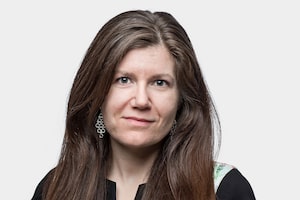Members of DirtBabe Collective teach climbing during the three day intro-to-climbing program for Indigenous women at Wasootch Slabs in Kananaskis Country, Alberta.Leah Hennel/The Globe and Mail
Sarah Eagle Bear is scared of heights. When she saw her friend, Cassie Ayoungman, document her mountain climbing adventures on social media, Ms. Eagle Bear struggled to imagine doing such a thing.
“When I’d see her posting, I was like: ‘This girl is crazy.’”
But Ms. Eagle Bear’s fear wasn’t the only thing keeping her grounded. Just the idea of accessing such an activity seemed like a stretch.
“I never really thought I’d be given the opportunity to even try,” Ms. Eagle Bear said. Then she noticed Ms. Ayoungman, who is originally from the Siksika Nation, post about climbing courses tailored for Indigenous people. Ms. Eagle Bear, who does not even hike, signed up for a women’s multiday climbing course in Kananaskis Country. A Blackfoot elder joined the group, providing a cultural component to the camp.
Ms. Eagle Bear, who is from the Blood Tribe in southern Alberta, said it was the first time she had ever come across a program catering to someone like her. “It was just easier to be vulnerable and open with people that I felt had the same background, and almost the same upbringing, as me,” she said. “This definitely opened the doors for me.”
Cassie Ayoungman teaches climbing to members of her community, Siksika Nation, during the three day intro-to-climbing program.Leah Hennel/The Globe and Mail
Even Ms. Ayoungman, who organized the courses, did not grow up in an outdoorsy family. The mountains were more of a curiosity to her than a playground. But, as she got older, they sucked her in. She wanted to explore. Spending time in the mountains bolstered her mental health, but finding Indigenous counterparts proved difficult.
“There wasn’t much diversity in the mountains,” she said. “It was always just me.”
And so Ms. Ayoungman, now an experienced climber living in Canmore, wanted to make it easier, more inviting, for Indigenous people to learn her sport.
“It is not just about climbing. It is about getting out of your comfort zone, growing as a person, seeing your progress, and taking what climbing has taught you to your everyday situations,” she said. “I just want to be able to show other Indigenous people what the mountains have done for me.”
She teamed up with DirtBabe Collective, a trio of women creating programs to get other women into the wilderness. Ms. Ayoungman credited the group with securing a $2,500 grant from Arc’teryx for the multiday women’s course, along with other donations. Canmore’s GearUp Mountain Sport and Rentals, marketing agency OnwardUp, and the Save-On-Foods in Golden, B.C., also provided necessities.
Blackfoot Elder Alvine Soyipiiksaki Wolfleg Eagle Speaker (center) shares traditional teachings and prayers with the program participants.Leah Hennel/The Globe and Mail
Ms. Ayoungman organized four events over the climbing season, including the three-day camp for women. Five participants signed up for the multiday course and, collectively, about two dozen joined the three one-day courses, which were not restricted by gender. The courses were free for participants and all the gear was provided.
Sarah Steele Johnston is one of DirtBabe’s co-founders, with a background as an addictions support worker at a wilderness-based treatment centre. The climbing courses build resilience and teach coping mechanisms that are useful beyond summiting the Rockies, she said.
Though a rookie at the outset, Sarah Eagle Bear said the multi-day course was a life-changing experience. The cultural elements, such as the morning smudges, lifted her spirits.Leah Hennel/The Globe and Mail
“Climbing can be used as a vehicle to teach women how to approach barriers that they may encounter in their lives,” she said. “Climbing is a really amazing metaphor for the barriers that we will encounter emotionally, mentally, and physically – especially for a population that is marginalized and coming up against oppressive structures.”
For Ms. Eagle Bear, the multi-day course was a life-changing experience. The cultural elements, such as the morning smudges, lifted her spirits. The other Indigenous women made her comfortable being vulnerable and cheered her on, and watching Ms. Ayoungman’s leadership was inspiring.
On the last climb of the first day, Ms. Eagle Bear got scared. Somewhere around the middle of the climb, she freaked out. She wanted to cry. But she slowed herself down and pushed through it.
“It was just something I don’t think I’ve ever done for myself,” she said. “Being able to understand my limits and being able to understand that I can go above them and beyond them.”
Program participants look on as Daniele Tailfeathers climbs the Wasootch Slabs in KananaskisCountry.Leah Hennel/The Globe and Mail
We have a weekly Western Canada newsletter written by our B.C. and Alberta bureau chiefs, providing a comprehensive package of the news you need to know about the region and its place in the issues facing Canada. Sign up today.
 Carrie Tait
Carrie Tait